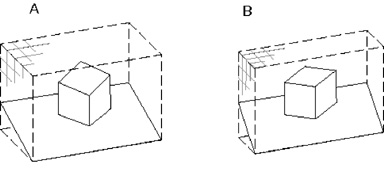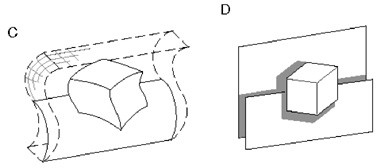
| Back | Return to Beginning | Next |
How literally are we to take the notion of actual pictures in the brain? Is it possible for spatial experience to be expressed in non-spatial form in the brain? To address this question we consult the Gestalt principle of isomorphism, in conjunction with information theory.
Consider the experience of a block resting on a surface, as suggested in A, below. The information content of that experience is equivalent to a painted cardboard model of the scene, composed of solid volumes bounded by colored surfaces, embedded in a spatial void. This suggests that there is some mechanism in the brain that represents a volume of perceived space, and within that volume are distinct volumetric regions representing solid volumes bounded by colored surfaces.

The isomorphism required by Gestalt theory is not a strict structural isomorphism, a literal isomorphism in the phsyical structure of the representation, but rather, it is merely a functional isomorphism, a behavior of the system as if it were physically isomorphic. For example the same information content can be encoded in the distorted model shown in B, above, which is identical to A except that the depth dimension is compressed relative to the other two, like a bas-releif sculpture. If the defined scale of the model is also correspondingly compressed, as suggested by the compressed grid lines, then this model too is isomorphic with the perceptual experience, because the flattening of the depth dimension is not really registered in the model, because the perceived cube spans the same number of gridlines in here as in here. Although this structure is no longer structurally isomorphic, it remains topoligically isomorphic because it preserves the spatial relations in the perceived scene.
The model can even be warped, as by the gyri and sulci of the cortical surface, as shown in C below, while remaining topologically isomorphic, and thus possessing the same information content as the spatial experience it encodes. The warping of this representation would not be apparent to the percipient, because the very definition of straightness is warped along with the space itself, as suggested by the warped grid lines.

Consider by contrast the flattened representation in D above, which has been segmented into discrete depth planes that distinguish only foreground from background items. This model is no longer isomorphic with the perceptual experience because unlike this model, the perceptual experience manifests a specific and distinct depth value for every point in each of the surfaces in the percept. This is the kind of isomorphism suggested by Köhler.
There is a dimensional mismatch between this world of volumes and surfaces, and the constellation of discrete activations suggested by neural network theory. Far from being a reduced or abstracted featural decomposition of the world, the world of perceptual experience encodes more explicit spatial information than the sensory stimulus on which it is based. There is no accounting in contemporary neuroscience for this constructive or generative aspect of perceptual processing.
The challenge for neuroscience therefore is to identify the three-dimensional volumetric imaging mechanism in the brain that is responsible for the spatially structured world of experience.
| Back | Return to Beginning | Next |